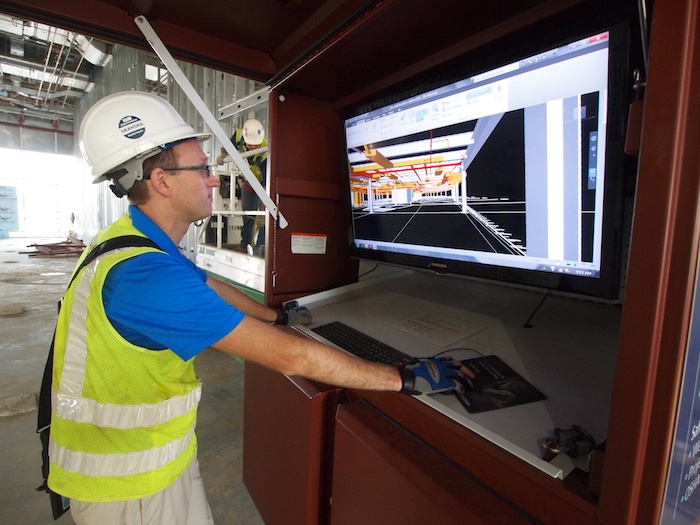 One of the most remarkable aspects of the construction technology space is the sheer amount of partnerships and collaboration across stakeholders. Point solutions or function-specific solutions don’t work at the fast-moving jobsite, and increasingly, companies are teaming up to integrate their solutions into the existing construction workflows, maximizing their value to contractors.
One of the most remarkable aspects of the construction technology space is the sheer amount of partnerships and collaboration across stakeholders. Point solutions or function-specific solutions don’t work at the fast-moving jobsite, and increasingly, companies are teaming up to integrate their solutions into the existing construction workflows, maximizing their value to contractors.
These inter-industry integrations are all around us. Autodesk recently acquired Assemble Systems, which tethers jobsite data to building information modeling (BIM), in addition to launching their Forge platform at Autodesk University last year. PlanSwift recently partnered with Sigma Estimates to allow an easy transfer of data between the two programs, streamlining the takeoff and estimating processes.
Another exciting example of new-age construction collaboration between established enterprises and growing technology companies is that of Oracle Construction and Engineering teaming up with Triax Technologies, which was announced at the Oracle Industry Connect in April.
 We sat down with Triax Technologies CEO Chad Hollingsworth to get down to the core mission driving Triax: partnerships. “This is a relationship-driven industry and that extends to solutions providers. Seeing big and small companies work together is one of the more exciting developments in the space. At Triax, we’re working to build out the connected jobsite, providing real-time insights on workers, equipment, tools, and more. We recognize that we can’t do this alone, and it’s great to see companies partnering to bring tech to the jobsite.”
We sat down with Triax Technologies CEO Chad Hollingsworth to get down to the core mission driving Triax: partnerships. “This is a relationship-driven industry and that extends to solutions providers. Seeing big and small companies work together is one of the more exciting developments in the space. At Triax, we’re working to build out the connected jobsite, providing real-time insights on workers, equipment, tools, and more. We recognize that we can’t do this alone, and it’s great to see companies partnering to bring tech to the jobsite.”
This partnership integrates Triax’s flagship product, Spot-r, into the widely-used Oracle Prime Projects platform. Spot-r collects safety, location, and activity data from workers and equipment at the construction site. With information into where workers are spending time on site, for example, project leaders can begin to recognize sources of non-tool time, such as material piles on the first floor when work is taking place on the 12th floor. By automatically detecting worker falls and providing a push-button for workers to report unsafe conditions or signal distress, contractors can better quantify safety and risks on site to improve processes and outcomes.
“What we’re doing is integrating Triax’s technology and data with our solutions to improve the safety and productivity on job sites,” said Dr. Burcin Kaplanoglu, the Senior Director of Industry Strategy and Innovation at Oracle Construction and Engineering. Both Hollingsworth and Kaplanoglu believe these partnerships are vital to technology adoption at the jobsite as well as the growth and future of the built industry.
“We are a pivotal point in our industry with technology, and there are a lot of solutions hitting the market trying to solve the industry’s problems,” said Kaplanoglu. “We at Oracle believe partnerships create an ecosystem that benefits our customers, the industry, and Oracle. That view was the impetus for our new Innovation Lab facility, which is a simulated project worksite with integrated technologies that enable us to really bring to life the power of an integrated project delivery solution ecosystem.”
Hollingsworth echoed this mentality, noting that “technology companies like Triax are nimble and able to try things. We can bring some of that flexibility to larger companies or help build out their offering, and they bring tremendous experience, resources and reach.”
Technology and the influx of real-time data it provides can bring critical project intelligence, but only if solutions are adopted and data is acted upon.
Hollingsworth believes partnerships like the one between Triax and Oracle will only benefit the industry.
“I think you’re going to see integrations continue to become more meaningful,” said Hollingsworth. “Cooperation between companies is going to result in a safer, more efficient job site.”
This article was brought to you in partnership with Triax Technologies. Learn more about them here.




Discussion
Be the first to leave a comment.
You must be a member of the BuiltWorlds community to join the discussion.